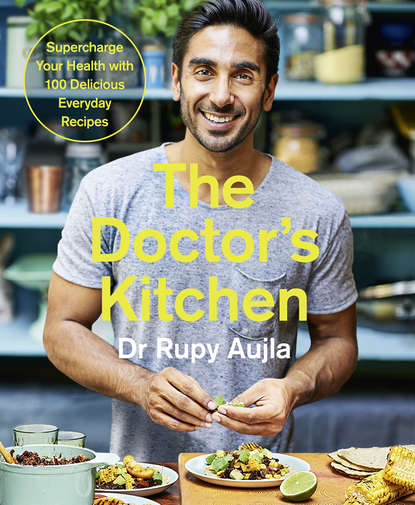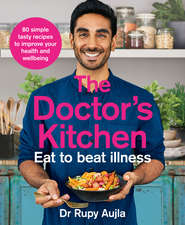По всем вопросам обращайтесь на: info@litportal.ru
(©) 2003-2024.
✖
The Doctor’s Kitchen: Supercharge your health with 100 delicious everyday recipes
Автор
Год написания книги
2018
Настройки чтения
Размер шрифта
Высота строк
Поля
Cumin is a functional spice that contains myriad compounds thought to be anti-bacterial and blood-sugar regulating (among many other claims of traditional medicine).
Unfortunately, again, there are not many human clinical trials examining the exact effect of this spice and when there are, they’re not conducted well.
What we do know is that it contains a really high antioxidant capacity as well as particular compounds that have been implicated in reducing inflammation and fighting cancer.
I couldn’t cook without cumin (or ‘jeera’, as it’s known in my kitchen). Used as ground seeds or whole seeds, it has an assertive taste that is distinctly Indian in my mind, but is very easily incorporated into a variety of dishes. Use it to transform your roast dinners, spice up your omelette or add an exotic hint to any meal. And, if you use it frequently, buy a bag of it from your local Indian store, not a thimble-sized jar!
Cinnamon
Another aromatic, antioxidant-packed, flavour bomb. The compounds in cinnamon have been investigated in order to explain why this spice has anti-inflammatory effects and improves metabolic syndrome.
Study after study reports potential mechanisms of action, and the biology, for someone interested in why spices have medicinal benefits, is groundbreaking. Reading some of the texts is like going back into pharmacology lectures at medical school. It’s a fascinating field of research that I hope will unravel more information, but for now, experiment with cinnamon in my spices, dressings and pastes (see here (#litres_trial_promo)) to elevate simple dishes.
Its versatility permeates through savoury and sweet dishes, drinks and dressings, modern European cuisine to rural Indian meals. It’s no wonder cinnamon used to be more valuable than gold in Egyptian times. Invest in a large, high-quality tub of it – you cannot have a kitchen without this spice.
Basil, rosemary, thyme
The incredible health properties of herbs and spices are not exclusive to those shipped in from the Far East or Africa. We have some amazing flavour enhancers that are easy to grow here in the UK in a pot in the kitchen, and that have as much functional benefit as the most expensive and beautiful saffron from Iran.
Basil, rosemary and thyme may seem unassuming, but the library of chemicals held within their leaves is inspiring. At the average ‘doses’ that we tend to use in cooking, they contain exceptionally important dietary sources of chemicals that reduce oxidative stress and attenuate inflammation.
The theories of heightened inflammation and its role in lifestyle-related disease, such as blood pressure, stroke and diabetes, is very fashionable in medical conferences these days.
Any inclusion of foods that can reduce our inflammatory burden is welcome, and these delicious, cheap, widely available herbs are worth every stalk.
Adding roughly chopped basil to Italian recipes adds an extra depth of flavour. Thyme, perhaps one of the first herbs to be recognised for its medicinal qualities, is in everything, from my fresh barbecue rubs (see here (#litres_trial_promo)) to my twist on shakshuka (see here (#litres_trial_promo)). Pestos, marinades, green curry pastes, aioli … the options are limitless and, as a doctor, I cannot recommend highly enough that you include these herbs in your daily diet.
Any inclusion of foods that can reduce our inflammatory burden are welcome, and these delicious, cheap, widely available herbs are worth every stalk.
Seeing past the herb garden
We really need to start investigating spice compounds further. We know that they are safe for consumption because we’ve essentially been testing them by including them in our diets for years,
and exciting early research suggests a potential role for their use in treating different conditions.
Don’t get too fixated on the exact amounts of antioxidants or measurements of compounds in an individual spice. First, not all the evidence looks at specific ‘dosing’ of ingredients, and second, they have varying effects in our body. The best advice is to consume a complement of different herbs and spices daily. Their synergistic effects have been shown to heighten their physiological properties,
as well as adding a delicious complexity to food.
These are some of my favourite spices, but it’s by no means an exhaustive list. I’ve also written a section on spice combinations in the recipes section (see here (#litres_trial_promo)) to help you get creative. Label your own spice blends – it’ll impress your friends and help get kids into the kitchen!
Worth the extra spend?
Patients often ask me whether they should spend money on ‘health foods’.
I’m encouraged by the fact that more people are interested in food, experimenting with different ingredients and at least attempting to live healthier lives, but the ‘superfood’ trend has its downsides. It has tainted the image of organic as something only attainable for conscientious middle classes, and perusing the aisles of ‘health’ sections in major supermarkets, you can forgive people for thinking eating well is costly. Some ingredients that caught media attention in recent years are incredibly expensive, and are backed by ‘research’ which is questionable in a lot of cases. I often get asked ‘which ones are worth the money’?
As a foodie, I’ve probably tried most of them. But, importantly, I judge them on the evidence base of their supposed health benefits as well as their taste. If we choose to spend an exorbitant amount of money on these ingredients, they’d better be worthwhile! Bitter gourd juice has been shown to improve glucose control in diabetics, but the taste is frightful! And I can’t see Western palates taking to ‘Amla’ powder any time soon.
However, the following ‘health’ ingredients, add flavour and texture and I believe are worth the extra pounds on your weekly shopping bill.
Hemp seeds
These are one of the most concentrated sources of plant-based protein available. The seeds have a whopping amount of fibre and a great fatty acid profile to make them a potentially heart-health-promoting product.
The Omega-3 fatty acids they contain are an important source of fats for largely plant-based eaters like myself.
The nutty and slight oily texture of the seeds makes them a great addition to smoothies or granola, and toasted with spices they make an awesome salad topper. The seeds are easier on your digestion than most processed protein powders and far more nutritionally dense.
In fact, I don’t use protein powders any more in my post-workout smoothies because shelled hemp seeds are brilliant and, on balance, much cheaper than those outrageously large tubs I used to buy.
Cacao powder
Raw cocoa beans are roasted and ground to create this bitter, antioxidant- and flavanol-rich product that I use in everything from Mexican Mole (see here (#litres_trial_promo)) to vegan ice cream. Most people aren’t aware of its incredible amino acid profile. It’s a complete protein (i.e. it contains all nine essential amino acids) and its phytochemical profile is off the charts!
It’s thought to potentially reduce the risk of stroke,
elevate mood by preventing tryptophan destruction
(an amino acid used in synthesis of the neurotransmitter serotonin) and improve cardiac function by increasing nitric oxide levels in the blood.
It is even suggested that cacao has a positive effect in neurocognitive disorders like dementia,
but while I welcome this fascination surrounding polyphenol-rich foods, I wouldn’t get too overexcited. Cacao may have potential applications in the future of medicine, but for now, let’s focus on its culinary uses!
Once you know how to use cacao, it becomes worth the expense, and since the ‘drink of gods’ has become so popular, it has also become a lot cheaper! The lengthy process of making the raw powder justifies its price, and the depth of flavour it offers makes it a worthwhile purchase. Look for 100 per cent powder, not cocoa with added dried milk products and sugar. Follow some of my simple recipes (see here (#litres_trial_promo) and here (#litres_trial_promo)) to discover how versatile it is in both savoury and sweet dishes and acquire the taste for this wonderful ingredient. You can get the same nutritional benefits from using high-quality dark chocolate powder, which I don’t think I could live without (75 per cent cocoa solids or higher is ideal).
Quinoa
I still get some eye rolling when I mention quinoa to my colleagues! But quinoa in all its coloured varieties is a really worthwhile addition to your diet. It’s good value and widely available, it’s easy to cook and it has a better nutritional profile than rice, bread or pasta (higher in protein, with more vitamins and minerals
), plus we even produce some right here in the UK! It contains all essential amino acids and the dark varieties possess even more antioxidants than the white.
It has been labelled as a potential ‘functional food’, because it may help reduce the incidence of high blood pressure, metabolic syndrome and stroke.
This is quite a claim to make, given the lack of human studies testing these theories,
but is certainly an area to watch.
Note, however, that these potential benefits don’t extend to every product just because it has quinoa in it. If a chocolate bar has some sprinkled puffed quinoa grains on top, this does not automatically make it a protein-rich, blood-pressure-reducing functional food! I recommend cooking with whole quinoa, and using it in both savoury and sweet dishes.
Extra-virgin olive oil
A cornerstone of the Mediterranean diet, the popularity of this polyphenol-rich fat has fluctuated in recent years, as it has found itself caught up in the battle of opinion on what constitutes a healthy plate, but I use good-quality olive oil liberally.
In the context of a low-sugar, nutrient-dense diet, olive oil has been shown to potentially be protective of heart health
and, importantly, makes food so much more enjoyable. ‘EVOO’, as it’s affectionately called by health bloggers, is thought to reduce oxidative stress because of its good fatty acid content






